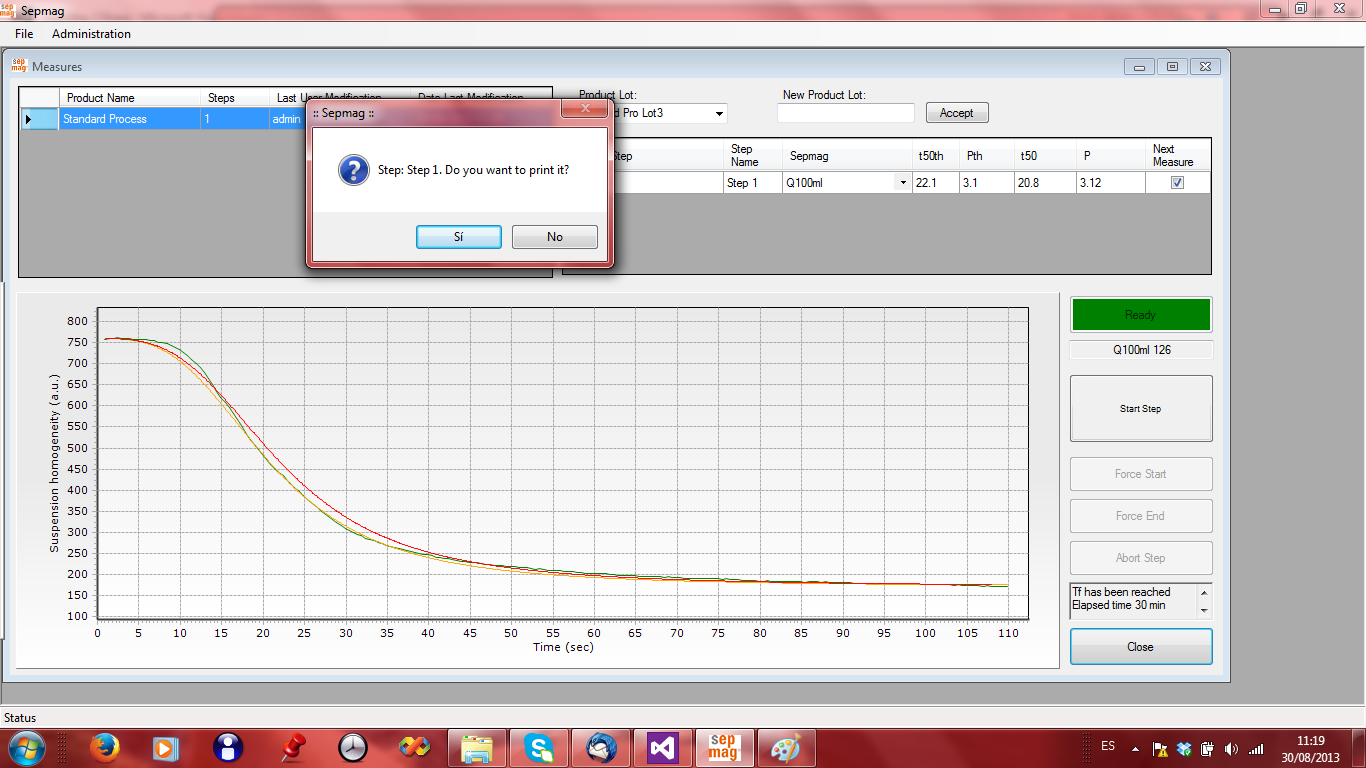Successfully scaling-up biomagnetic separation processes relies on determining the right working conditions. Having a constant magnetic force in the whole working volume guarantees the in-lot consistency, but manufacturing also needs to guarantee the lot-to-lot consistency.
The consistency of a lot is usually determined at the end of the manufacturing process, checking the functional properties of the product, as it can be the RLU in CLIA kits.
The control over the biomagnetic separation steps of the process is usually eyesight. The technician responsible of the process looks if the suspension has become transparent at the specified separation time. This approach has several flaws. First, it only gives information about the state of the suspension at separation time, but does not gather data about how the transparency evolves during the process. If the separation has been faster than it should (an indicator of wrong concentration, bead diameter or magnetic moment), the transparency at the separation time would the same, making impossible to distinguish the wrong process from a correct one.
The second flaw is the subjectivity of the measurement. Two different persons may have different visual criteria for considering the ‘transparency’ achieved, leading to a higher variability for the acceptance of the batch, thus increasing the variability on the resultant product.
If it is a problem on the batch, it would probably not be detected until the latest steps of the process. But then, it would be difficult to determine at which step the problem occurred.
The ideal situation would be to monitor the whole biomagnetic separation process. Since the suspension is dark when homogeneous (before separation) but becomes transparent when the solid phase has been separated, we can record the optical changes during the process. The resulting curves can be used as an objective record of each single lot.
When the biomagnetic separation process is performed using advanced systems, the magnetic force is constant and the field pattern generated by permanent magnets. Using these conditions, changes in the behavior would be directly related to changes in the suspension, and the sigmoidal-like curves can be used as quality control. If the magnetic beads are irreversible aggregated in one separation step, in the next separation step would show faster separation than expected. In the example, the optical monitoring of two sequential washing steps reveals that the second one (lighter curve) shows a different behavior. A naked-eyed observation would probably give a ‘pass’ status, as both processes had achieved whole transparency at the separation time (115 seconds in the example). The sigmoidal curve, by contrast, quantifies the difference as the reduction of the t50% (when 50% of the transparency is achieved) from 37 to 22 seconds. This big difference should rising an early quality alert, but also gives us some clues about the problem cause: magnetic beads move faster when the diameter is larger (concentration also can lead to quicker movement, but would also change the shape). As in the example the beads are the same –no new beads have been added between the washing steps-, the ‘apparent’ diameter increase is probably caused by irreversible aggregates acting ‘bigger’ beads.

For each process step, standard curves can be generated (defined by the expected sigmoidal shape). The transparency curve of every single biomagnetic separation step can then be compared with its standard. Thus, technicians have a powerful tool to detect if something is wrong during the separation process: wrong magnetic beads diameter/magnetic charge, incorrect beads concentration, problems with buffer viscosity.
The transparency curves also provide the production team and the QC-manager with an audit tool to objectively discuss and review the issue on the process, saving time, money and discussions. The alerts generated by deviation from the biomagnetic separation standard curves permits earlier corrective actions or, if necessary, discard the batch. For large volume production that means big savings on the unnecessary wasted resources (antibodies, buffer, magnetic beads…) dedicated until final QC detects the problem, but also using the time saved to complete the production on time or with minimal delays. Moreover, all this benefits can be obtained at no cost, as monitoring option is included in all the advanced biomagnetic separation systems.
Related post:
- Know How Your Particle Magnetic Behaves
- How to Select the Right Biomagnetic Separation Conditions
- How to Scale-up the conditions to a new volume





